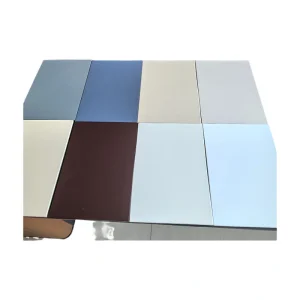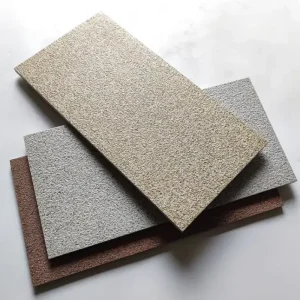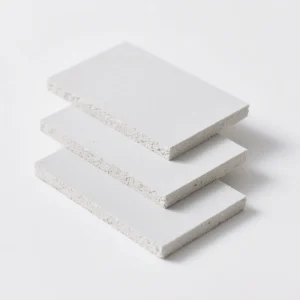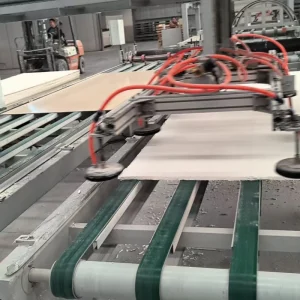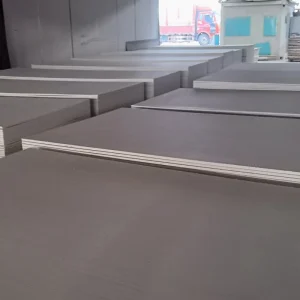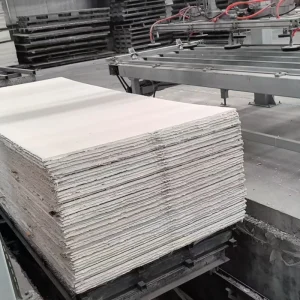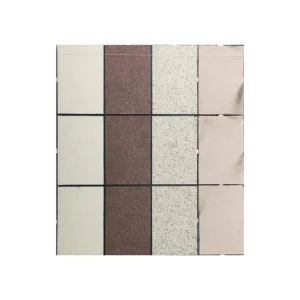1.Introduction to Calcium Silicate Insulation Materials
Calcium silicate insulation materials are divided into tobermorite (6CaO·5SiO2·6H2O) and xonotlite (6CaO·6SiO2·H2O). Tobermorite has a maximum operating temperature of 650°C and is synthesized by atmospheric pressure autoclaving; xonotlite has a maximum operating temperature of 1000°C and is synthesized by dynamic autoclaving hydrothermal synthesis. Generally, the refractory industry only uses xonotlite insulation products. Xonotlite, with its low crystalline water content, excellent temperature resistance, excellent thermal insulation, and safety and environmental protection, has earned it a high reputation in high-temperature industries and is widely used in the cement industry.
Currently, the world’s largest producer and most technologically advanced country for ultra-lightweight calcium silicate insulation materials has achieved mass production of ultra-lightweight xonotlite products with a density of 110 kg/m2. In the late 1980s, the China Building Materials Science Research Institute successfully developed xonotlite products with a bulk density of 200 kg/cm3. However, progress in this area has been minimal over time. Currently, there’s still a significant gap between my country and developed countries in the key performance indicators of xonotlite: density and thermal insulation.
2.The Relationship Between H2O Pressure and Temperature
The synthesis of calcium silicate products requires high temperatures. Therefore, autoclaving is necessary to conduct the hydrothermal synthesis reaction at temperatures exceeding 100°C. The figure shows the relationship between temperature and pressure in the autoclave at a water-to-solid ratio of 40.
Under normal pressure, water boils at 100°C. To conduct a hydrothermal reaction at temperatures above 100°C, the required temperature must be achieved in a sealed container by increasing the pressure. Generally, increasing the temperature increases the reaction rate. However, increasing the temperature also requires increasing the pressure, which requires consideration of the pressure resistance of the equipment. Therefore, for safety reasons, the autoclave temperature is typically kept below 230°C.
3.Dissolution of CaO and SiO2
When exposed to water, the surface of the lime particles immediately hydrates, forming calcium hydroxide and releasing a large amount of heat energy. Due to the volume effect of the reaction products, calcium hydroxide disintegrates and enters the water. Lime particles expose new surfaces, allowing hydration to continue. This process continues until all the lime is hydrated. The solubility of calcium hydroxide is not high and decreases with increasing temperature, as shown in the figure.
The solubility of silicon dioxide increases with increasing temperature. For quartz, its solubility is very low at low temperatures, reaching only 0.06 g/L even at 150°C. However, after 150°C, its solubility increases rapidly, reaching 0.15 g/L at 174°C, 0.24 g/L at 200°C, and 0.43 g/L at 240°C, as shown in the figure.
4.Phase Equilibrium of the CaO-SiO2-H2O System
The CaO-SiO2-H2O system contains 12 minerals. Among them, CSH(A), CSH(B), tobermorite, and xonotlite are relevant to calcium silicate insulation products.
CSH(B) is a poorly crystalline material, with crystals mostly around 1 μm in size and fibrous in shape.
CSH(B) can be produced by reacting lime with amorphous SiO2 or by autoclaving lime and finely ground quartz sand at 125-175°C. In the CaO-SiO2-H2O system, a hydrate even less crystalline than CSH(B) can be formed, called C-SH gel.
CSH(A) is a long, plate-like crystal that can be converted from CSH(B).
Tobermorite (6CaO·5SiO2·6H2O) is a thin, plate-like crystal with a size of approximately 2 μm or less. Tobermorite can be synthesized from lime and quartz powder at 130-175°C, but the synthesis time is about twice as long as that of CSH(B).
Generally, xonotlite (6CaO·6SiO2·H2O) is a fibrous crystal that decomposes at approximately 850°C. Xonotlite can be synthesized using CaO and SiO2, which match its chemical formula, at temperatures between 150 and 400°C. The synthesis rate increases with increasing temperature. Synthesis of well-crystallized xonotlite at 200°C requires 100 hours. However, at 300°C, it only takes 5 to 10 hours.



